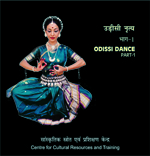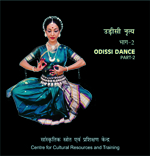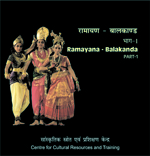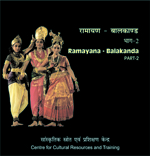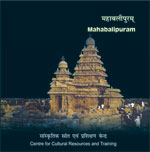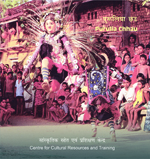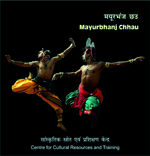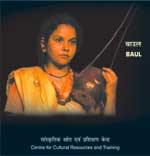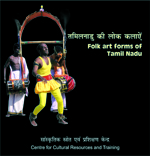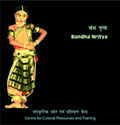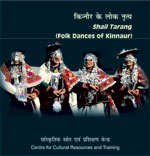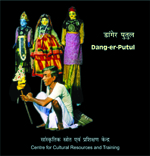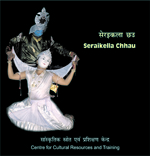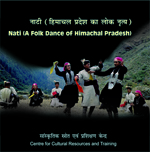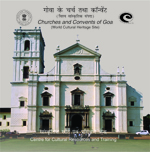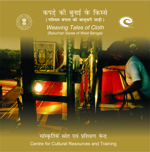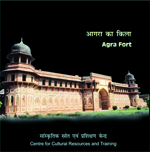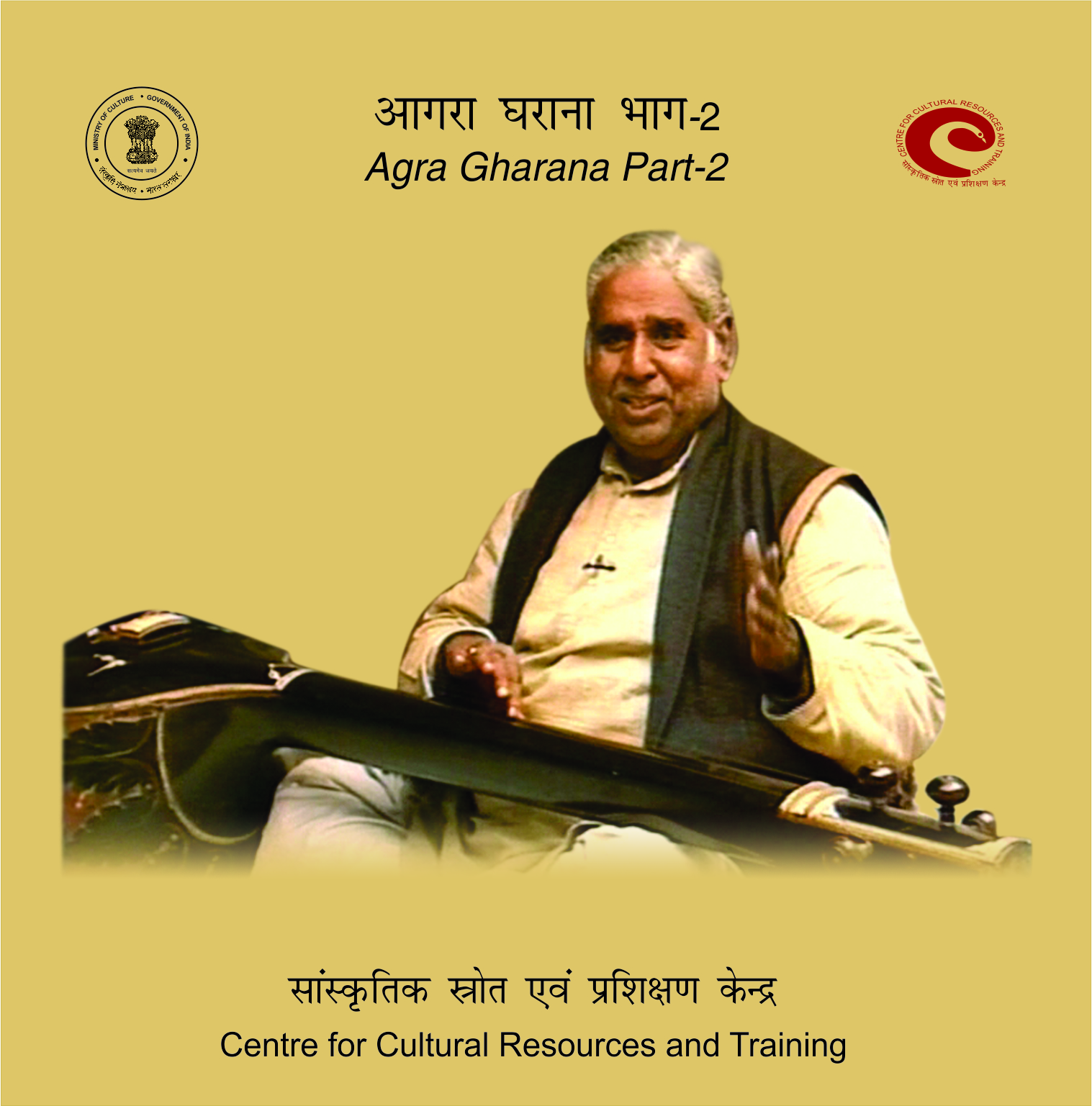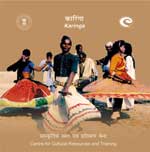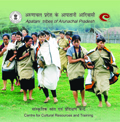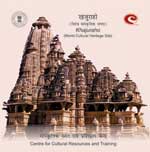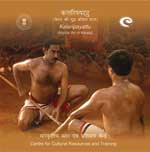
Audio Visual Catalogue
VIDEO DVDs
Odissi Dance- Part 1
CCRT/DVD -1 | duration- 45:16 min.
Odissi is the classical dance form which originated in Orissa. As in most Indian dances, Odissi has also been influenced by religious beliefs. Odissi follows the division of Nritta, dealing with the aesthetic arrangement of abstract movements of the body, and Nritya employing facial expressions, hand gestures and body movements to convey a particular emotion. A film on Odissi dance depicts aspects of Nritta and Nritya. Manglacharan, Batu, Pallavi, Abhinaya and Moksha have been explained and demonstrated by Madhvi Mudgal, a renowned Odissi dancer
Odissi Dance- Part 2
CCRT/DVD – 2 | duration- 22:33 min.
Odissi is the classical dance form which originated in Orissa. As in most Indian dances, Odissi has also been influenced by religious beliefs. Odissi follows the division of Nritta, dealing with the aesthetic arrangement of abstract movements of the body, and Nritya employing facial expressions, hand gestures and body movements to convey a particular emotion. A film on Odissi dance depicts aspects of Nritta and Nritya. Manglacharan, Batu, Pallavi, Abhinaya and Moksha have been explained and demonstrated by Madhvi Mudgal, a renowned Odissi dancer
Ramayana- Balkanda (Bharatanatyam Dance- Part 1)
CCRT/DVD – 3 | duration- 54: 25 min.
The Bharatanatyam style originated in southern India particularly in the south- eastern area of Tamil Nadu. It is now performed not only in all parts of India but has gained popularity in abroad as well. In this ancient art form all aspects of Indian dance – Nritta, Nritya and Natya are present. A video film has been prepared depicting Balkanda episode from Ramayana in Bharatanatyam dance style. It has been choreographed under the guidance of renowned dancer, Sudha Rani Raghupathy.
Ramayana- Balkanda (Bharatanatyam Dance- Part 2)
CCRT/DVD – 4 | duration- 47:25 min.
The Bharatanatyam style originated in southern India particularly in the south- eastern area of Tamil Nadu. It is now performed not only in all parts of India but has gained popularity in abroad as well. In this ancient art form all aspects of Indian dance – Nritta, Nritya and Natya are present. A video film has been prepared depicting Balkanda episode from Ramayana in Bharatanatyam dance style. It has been choreographed under the guidance of renowned dancer, Sudha Rani Raghupathy.
Folk Dances of Sikkim
CCRT/DVD – 7 | duration – 28 min.
A variety of communities live in Sikkim, each contributing to the performing arts of the region. There are the ‘Lepchas’, the earliest settlers of Sikkim. Then there are the ‘Bhutias’, mainly descendants of the early settlers from Tibet and Bhutan and finally the ‘Nepalis’ who came from Nepal and settled in Sikkim. Each of these have distinctive repertoire of folk songs and dances almost for every social or religious ceremony.
Jaisalmer (The Golden City)
CCRT/DVD -11 | duration- 24:49 min
Jaisalmer, the capital of Bhattis is situated amidst the tract of country known according to ancient geography as Marusthali, the desert of India. The video film depicts the splendor of Jaisalmer City and includes important buildings and monuments like Jaisalmer Fort, Havelis and Jain temples.
Gurukulas of Kerala
CCRT/DVD -16 | duration- 29:18 min
The concept and mode of education has undergone a sea change in India. Our education system has been completely westernized. The concept of ‘Gurukulas’ where knowledge is not a data bank of information, but a search for truth to transcendent the known is no more. But to our surprise the practitioners of art and music still live in the old tradition of ‘Gurukulas’. The guru is not only a great authority of knowledge, but also a humble guide to the exploration of the known to the infinite of the unknown.
Raas (Manipuri dance)
CCRT/DVD – 26 | duration- 22:26 min.
Raas is one of the most famous classical dances of India, known for its rhythm, grace and a poetic beauty of movements. The ‘Raas’ is a living tradition in Manipur. At the end of the lila, Krishna asks the gopis to return to their respective homes as dawn is approaching fast and they reply, ‘May we always be born again as gopis’. This is the true sentiment of the raas. It is reflected in the heart of every member of the audience, each of whom wants to be united with the divine spirit. This passion is based on ‘shringarbhakti’ or a devotion born of love for the Supreme. In it we find a simple and human approach in which desires, aspirations and feelings become a part of the love for God
Mahabalipuram (World cultural heritage site)
CCRT/DVD – 29 | duration- 23:24 min.
The Pallavas were ruling in the far south, prior to the rule of Harshavardhana of Kannauj who reigned in northern India in the seventh century A.D. The capital of their empire was at Kanchipuram and the sea-port at Mahabalipuram. The city of Mahabalipuram runs parallel to the Bay of Bangal. The area was famous port from ancient time and this fact was established by an anonymous Greek navigator of the first century A.D. It is also known as Mahabalipuram, named after the great Pallava ruler Mamalla.
The story of south Indian stone architecture begins at Mahabalipuram. The three major styles of architecture at Mahabalipuram are of the time of Mahabalipuram, his son Narasimhavarman and Rajasimha. The Mahabalipuram style is the earliest and the simplest found in the rock-cut temples. In the cave temples of Narsimhavarman or the Mammalla style, the pillars are slender, ornamented and are supported by squatting lions. In the Rajasimha period, temples were constructed by blocks of granite stone. Each of the caves at Mahabalipuram is unique. The sculptural reliefs, the panch Pandava Ratgas, the Shore temple are the important landmarks of artistic achievements of the Pallavan rules.
Purulia Chhau
CCRT/DVD -17 | duration-26:39 min
The Chhau dance are very popular in Bengal, Bihar and Orissa. There are Various styles of Chhau dances. of these Purulia, Seraikella and Mayurbhanj are most popular. The main differece amoung these dance styles lies in the use of masks. Purulia is the name of a district in West Bengal. Purulia Chhau is based on many episodes of ramayana and Mahabharata. Originally, a martial dance, it is traditionally performed in the open air and on the level ground. The eloborate masks, headgear, bright costumes ryhtumic drum beats and shehnai are the distinguishing features of Purulia Chhau.
Mayurbhanj Chhau
CCRT/DVD – 18 | duration- 23:44 min.
The Chhau Dance of Mayurbhanj, Orissa is among the most celebrated dance forms of India. The word Chhau is derived from Oriya word “Chhauni” the military camp where soldiers used to stay and practice the sword exercise. However, some scholars believe that the word Chhau is derived from such words as “Chhabi” (picturesque), “Chhai” or “Chhatak” (clowning) and “Chhaya” (shadow or mask).
The techniques of Mayurbhanj Chhau are based on vigorous body movements and leaps. These are popularly called chauk, dharan, chali and ufil. Chauk and dharan are the first basic standing postures learnt by the dancer. Chali is the rhythmic gait of the dancer of Chhau used for coming to the dance arena. Dress, costume and make-up play an important role in Chhau dance performance. Chhau music is generally accompanied by musical instruments of dhol, dhumba, nagara, dhansa and chadchadi.
Baul
CCRT/DVD – 19 | duration – 30 min
Bauls are idealized as emblems of Bengali folk culture. Bauls are bards, composers, musicians, dancers and actors all rolled into one, and their mission is to entertain. Through their songs, pauses, gestures, and postures, these nomadic mendicants spread the message of love and ecstasy to lands far and wide. People from an earlier generation will definitely remember the singing fakir passing with an Ekara and a bowl for alms. Baul song is about love for the Divine and celebrates celestial love.
Baul music is characterized by certain type of musical instruments like the ektara, the dotara, the dhol, manjiras etc. These instruments are made from natural substances like clay, bamboo, wood etc. and the results are sweet melodious tunes.
Bidesiya Nritya (Theatre form of Bihar)
CCRT/DVD – 8 | duration -29:46 min.
Bidesiya is a vastly popular, vibrant, throbbing performing art form of Bihar. As the name itself suggests, the soul of Bidesiya lies in the separation of a woman from her man as he goes to far off places to earn livelihood. The man who conceived, conceptualized and literally rejuvenated Bidesiya was Bhikhari Thakur. He produced a path-breaking play titled as ‘Bidesiya’ in which he played an important role. The central characters in Bidesiya performance are Nat and Nati. The costume of Nat is colourful Dolangi Dhoti, Kameez and Pagri, Nati ‘traditionally a male performer’ wears Ghaghra Choli. The musical instruments used are majira or jhanj, dholak, khajri, nagara and harmonium played by feet.
Folk Art form of Tamil Nadu
CCRT/DVD – 20 | duration- 28:42 min
Tamil Nadu is rich in a variety of folk music and dances. These have a special reference in reflecting the ethos and aesthetic values of the common people as they are closely linked to their life, philosophy, environment and routine. The practice of such forms is marked by active participation and popularity; fortunately, there are many artists with high degree of skill and professional competence.
Bandha Nritya (Odisha)
CCRT/DVD – 21 | duration- 28:26 min.
The Bandha Nritya, the root of today’s Odissi Dance, is performed by Gotipua dancers. Gotipua usually refers to boy dancers. The Gotipua lead an austere life in the Gurukul or Akhada. But enough care is taken to train them in each aspect of performing arts like dancing, singing, playing pakhawaj along with academic studies. The Gotipuas keep long hair and adorn female costumes. The boy dancers never use metal jewelry; they make their own ornaments with beads, stitched on velvet clothes for the arms, wrists and waists. Besides dance and music, the bandha dancers give equal importance to the abhinaya or mime and sahitya or literature.
As the word ‘bandha’ suggests it means ‘tie or bond’, different intricate postures and rhythmic stepping mingled with facial expression make up a dance sequence. The dance performed styling in acrobatic form encompassing the intricate postures is called Bandha Nritya .
Shail Tarang (Folk Dance of Kinnaur)
CCRT/DVD – 9 | duration- 20:42 min.
Of the twelve districts of Himachal Pradesh, one of them is Kinnaur. It is about 200 kms from Shimla on the banks of Sutlej river in the north eastern region of the state. The language of this region is Kinnauri. The folk dances are performed mainly to please gods and goddesses on occasion of social festivals, rituals and ceremonies. In their literary repertoire, folk dances of this region are known as kayang.
Dang-er-Putul
CCRT/DVD – 10 | duration- 27:27 min.
The Dang-er-Putul or the birch pole puppet is one of the richest and least known indigenous traditions of the Indian puppet theatre. It emerged and flourished in south-west Bengal, near Sunderban area. The Dang-er-Putul has drawn on Jatra for its themes and dramatic modes. In the hands of the peasants, village artisans, blacksmiths, potters, etc., it has been a more popular carrier for several theatric and cinematic ideas that have undergone transformation in their puppet manifestation.
Serailkella Chhau
CCRT/DVD – 5 | duration- 20:00 min.
Seraikella Chhau, dance of Bihar, is extremely lyrical and poetic in its execution. This form of dance i symbolic in nature where the repertoire includes themes like ‘raatri’ or night, ‘dhibor’ or the fisherman. Moments of finer elements and a general trend towards more classical movements than the martial stances are the important features of this form. the masks are soft, lyrical, delicately designed and painted, made out of light material as papier mache or wood.
Nati Dance (A Folk Dance of Himachal Pradesh)
CCRT/DVD-6 | duration- 20:00 min.
Himachal Pradesh takes its name from the word ‘Himachal’ meaning the abode of snow. In this territory of rugged high mountains and hills the local people keep their spirits up with song and dances. One of the most famous among these dances is the ‘Nati’ dance. it is known for its soft rhythm and beautiful accompanying lyrics.
Churches and Convents of Goa
CCRT/DVD – 28 | duration- 23:00 min.
Goa, situated on the western coast of India attracts a number of touists for it’s beautiful sea beaches and lush greenery. the Portuguese, who conquered Goa in 1510 C.E., made it the trade capital of their empire. Gradually, they took control of the neighboring areas and managed to channelise most of the trade on the west coast through the city. The Portuguese were not only interested in trade but has also come to spread the Christian religion.
With the coming of the Portuguese rulers, their religion as well as their way of life has a tremendous impact on Goan culture. Soon after they came, the Portuguese set about making the city of Velha Goa (Old Goa) their capital and it cameto be known as “the Rome of the Orient”. Splendid churches were constructed. Even today, there is an lberian aura of the old feeling that Goa must have looked like a ‘little Portugal’. The art of Euope is depicted beautifully in the Churches and Convents of Goa. These monuments have become an integral part of our cultural heritage.
The UNESCO bestowed the status of World Cultural heritage Site to Churches and Convents of Goa in the year 1986.
Poetry of Walls (Vishnupur Terracotta Temples)
CCRT/DVD- 12 | duration- 21:00 min.
Bishnupur was once a flourishing town and served as the capital of the Malla rulers of Bengal from 17th to 18th centuries. The most prosperous period of recorded Malla history begins with Veer Hambir, a contemporary of Akbar. It was in his reign that the first of the surviving temples was built at Bishnupur. At present there are as many as thirty brick and stone temples, each with a different design and scheme, scattered over a large area.
Weaving Tales of Cloth (Baluchari Saree of West Bengal)
CCRT/DVD-13 | duration- 18:00 min.
‘Baluchari’ is one of the most popular weaving techniques of Bengal. Puranic tales or legends of Ramayana and Mahabharata are depicted on the sarees. These tales form a part of the design and also become the visual depiction of popular folklores.
Agra Fort
CCRT/DVD-14 | duration- 24:00 min.
When Mughal Emperor Akbar came to rule he was just fourteen years old, but at the age of twenty three he launched his first major architectural venture by renovating the existing Lodi fort and beginning the construction of ‘Akbarabad Fort’ in Agra. It is considered to be the strongest fort in the plains of Indian subcontinent. Agra fort is three kilometers in circuit surrounded by a double wall of red sandstone, with flanking defenses, towers, turrets and crenellated battlements.
Konark
CCRT/DVD-15 | duration- 20:00 min.
Konarak lies on the shore of the Bay of Bengal. The temple is in a form of huge stone chariot designed like a mighty temple cart being pulled across the sky. As the sun measures time, the temple’s symbolism incorporates the same theme. The twelve wheels represents the month of the year, and its sixteen spokes the time of the day. Even today, Konarak stands in somber dignity as a representative of the thousands of artisans who worked on it for 16 long years.
Agra Gharana Part-I
CCRT/DVD-22 | duration- 45:00 min.
Gharana’s of music, although a subject so close to the heart of every musician, has rarely been systematically studied. The concept of ‘Gharana’ is a riddle to many lovers of music. Gharana’s are not schools, or groups of artists inspired by a common tradition or influenced by a common style. Gharana’s are more sectarian in their attitude and on the whole more akin to families of blood relations. The programme looks deep into the traditions and legends of Agra Gharana in Hindustani classical music.
Agra Gharana Part-II
CCRT/DVD-23 | duration- 39:00 min.
Gharana’s of music, although a subject so close to the heart of every musician, has rarely been systematically studied. The concept of ‘Gharana’ is a riddle to many lovers of music. Gharana’s are not schools, or groups of artists inspired by a common tradition or influenced by a common style. Gharana’s are more sectarian in their attitude and on the whole more akin to families of blood relations. The programme looks deep into the traditions and legends of Agra Gharana in Hindustani classical music.
Karinga
CCRT/DVD-24 | duration- 29:00 min.
अवध क्षेत्र की कहार, कुम्हार, अहीर, गड़रिया और दलित जातियों का नृत्य- संगीत ।
Apatani Tribes of Arunachal Pradesh
CCRT/DVD-25 | duration- 22:00 min.
Arunachal Pradesh is a land full of scenic beauty and an abode of rich cultural heritage.The lineage of this rich tradition comes from the cross-section of various tribes that have gathered here over the years. One of the most important of these tribes are the ‘Apatani’ better known for their fish cum paddy culture. Their beautiful cane and bamboo works are an example of their skilled craftsmanship, equally enchanting are their group dances.
Khajuraho (World Cultural Heritage Site)
CCRT/DVD-27 duration- 23:00 min.
Nestled among the valleys and ravines of Bundelkhand stands ‘Khajuraho’, once the capital of the Chandellas in early medieval times. The temples stand today as a testimony to the rich and prosperous days of Chandella realm, representing a distinct pattern of art and temple architecture of its own.
A visitor in many ways can appreciate Khajuraho. As a scholar, as a connoisseur of art, as a social historian or as a common man who finds in Khajuraho an equation for the inter-relationship of religion and intricacies of life rendered in winsome sculpture by the gifted artists of the Chandella days. The temples of Khajuraho stand as if in celebration of the union of Shiva and Parvati, which is the ultimate goal of life.
The UNESCO bestowed the status of World Cultural Heritage Site to Khajuraho in the year 1986.
Kalaripayattu (Martial Art of Kerala)
CCRT/DVD-30 | duration- 35:00 min.
Kalaripayattu, martial art of Kerala, is one of the oldest existing martial arts in the world. It is an art of the stage, drama, music and action eulogizing the manhood and the spirit of victory. The disciples start learning the art of payattu (fight) at the age of seven in kalaries i.e. the gymnasium for martial exercises. Years of discipline and hard work are required to train the body, the mind and oneself. When the body and mind attain harmony with the inner eye it acquires a blessed serenity. The heroic ballads of Kerala are legendary sagas of the heroes of the payattu.
Mohiniyattam
CCRT/DVD-31 | duration- 34:00 min.
Mohiniyattam is a solo dance tradition of Kerala in communion with the absolute eternal grace performed by a beautiful maiden, Prakriti offering herself through dance and music to the deity of the temple. It evolved as a part of temple ritual within the precincts of a temple linked to the tradition of devadasis. Its keynote is the shringarbhakti and the basic tempo is lasya characterized by highly feminine movements. It is an art meant primarily for spiritual expression.
Apart from mythology, Mohiniyattam contains a range of themes from nature.
AUDIO CDs
Azaadi Ke Geet (Songs of Freedom Movement)
CCRT/CD/1 | duration-45 min.
Songs of Freedom Movement’, an audio cassette, contains 13 songs on Freedom Movement. Some of the songs are ‘Vande Mataram’, ‘Sarfaroshi Ki Tamanna’, ‘Kadam Kadam Badaye Ja’, ‘Sare Jahan Se Achha Hindustan Hamara, etc. A booklet on ‘Freedom Movement Songs’ provides general information and complete text of the patriotic songs and their transliteration.
My Pledge to Freedom
CCRT/CD/2 | duration- 45 min.
My Pledge to Freedom’, an audio-cassette, contains speeches by renowned freedom fighters and national leaders, for example, Mahatma Gandhi, Pandit Jawaharlal Nehru, Netaji Subhash Chandra Bose, Sarojini Naidu etc. A booklet on ‘My Pledge to Freedom’ provides general information about the national leaders and their famous speeches.
National Songs, Part 1, 2 and 3
CCRT/CD/3 | duration- 60 min. each
This audio CD, contains songs in regional languages which are very popular with the teachers as well as students. To foster a spirit of national integration and develop a sense of appreciation for the beauty in music and different languages, songs from different regions and languages have been selected.
PRICE LIST OF AUDIO-VISUAL MATERIAL
| S.NO. | TITLE OF AUDIO-VISUAL MATERIAL | PRICES IN (Rs.) |
|---|---|---|
| CCRT/ DVD/ 1 | Odissi Dance Part 1 | 150/- |
| CCRT/ DVD/ 2 | Odissi Dance Part 2 | 150/- |
| CCRT/DVD/3 | Ramayana-Balkanda (Bharatanatyam Dance Part-1) | 150/- |
| CCRT/DVD/4 | Ramayana-Balkanda (Bharatanatyam Dance Part-2) | 150/- |
| CCRT/DVD/5 | Serailkella Chhau | 150/- |
| CCRT/DVD/6 | Nati Dance (A Folk Dance of Himachal Pradesh) | 150/- |
| CCRT/DVD/7 | Folk Dances of Sikkim | 150/- |
| CCRT/DVD/8 | Bidesiya | 150/- |
| CCRT/DVD/9 | Sahil Tarang (Folk Dances of Kinnaur) | 150/- |
| CCRT/DVD/10 | Dang-er-Putul | 150/- |
| CCRT/DVD/11 | Jaisalmer (The Golden City) | 150/- |
| CCRT/DVD/12 | Poetry on Walls (Vishnupur Terracotta Temples) | 150/- |
| CCRT/DVD/13 | Weaving Tales of Cloth (Baluchari Saree of West Bengal) | 150/-> |
| CCRT/DVD/14 | Agra Fort | 150/- | CCRT/DVD/15 | Konark ( The Black Pagoda) | 150/- |
| CCRT/DVD/16 | Gurukulas of Kerala | 150/- |
| CCRT/DVD/17 | Purulia Chhau | 150/- |
| CCRT/DVD/18 | Mayurbhanj Chhau | 150/- |
| CCRT/DVD/19 | Baul | 150/- |
| CCRT/DVD/20 | Folk Art form of Tamil Nadu | 150/- |
| CCRT/DVD/21 | Bandha Nritya (Odisha) | 150/- |
| CCRT/DVD/22 | Agra Gharana Part-I | 150/- |
| CCRT/DVD/23 | Agra Gharana Part-II | 150/- |
| CCRT/DVD/24 | Karinga (Uttar pradesh) | 150/- |
| CCRT/DVD/25 | Apatani Tribes of Arunachal Pradesh | 150/- |
| CCRT/DVD/26 | Raas (Manipuri Dance) | 150/- |
| CCRT/DVD/27 | Khajuraho (World Cultural Heritage Site) | 150/- |
| CCRT/DVD/28 | Churches and Convents of Goa (World Cultural Heritage Site) | 150/- |
| CCRT/DVD/29 | Mahabalipuram (World Cultural heritage site) | 150/- |
| CCRT/DVD/30 | Kalaripayattu (Martial Art of Kerala) | 150/- |
| CCRT/DVD/31 | Mohiniyattam | 150/- |
| DIGITAL SLIDE ALBUM | ||
| CCRT/DVD/1 | Performing Arts 1 & 2 | 300/- |
| CCRT/DVD/2 | Plastic/Visual Arts 1 & 2 | 300/- |
| CCRT/DVD/3 | Plastic/Visual Arts 3 & 4 | 300/- |
| AUDIO CDs | ||
| CCRT/CD/ 1 | Azaadi ke Geet (Songs of Freedom Movement) | 100/- |
| CCRT/CD/2 | My Pledge to Freedom | 100/- |
| CCRT/CD/3 | Song in National Languiages, Part 1,2 and 3 | 150/- |
The above material is available for sale, subject to availability at Centre for Cultural Resources and Training(CCRT), New Delhi, Udaipur, Hyderabad and Guwahati
The postage and handling charges for sending the material by post will be extra as per actual.
The payment for ordered material can be made either in Cash or by Demand Draft favouring "Director, Centre for Cultural Resources and Training, New Delhi"
For sales inquiry please contact
Centre for Cultural Resources and Training,
15-A, Sector - 7, Dwarka,
New Delhi - 110075
Telephone:(011) 25309300 Extn. 335, 351
E-mail:-prod.ccrt@nic.in
